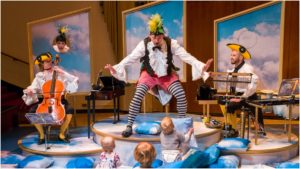
Opera Babies – Phelim McDermott & Lliam Paterson’s ‘BambinO’ Comes to the Metropolitan Opera
By David SalazarHow do you get new audiences into the opera house?
That question has puzzled companies for years as they try every trick in the book to bring millennials into the opera house. The art form, seemingly, depends on it.
But the Scottish Opera tried a new tactic a year ago, and it’s bearing some fruit. Why not start the exposure to opera from the onset of life, when children are most receptive to anything thrown their way?
Enter “BambinO,” an opera for children written by director Phelim McDermott and composer Lliam Paterson.
The idea was the brainchild of Jane Davidson, the Director of Outreach and Education at the Scottish Opera.
The first steps were to come to terms with how to communicate with the age group, which has never been made the central audience of any opera.
“We improvised with how you talk to babies. Then got the performers to do that and slowly went into doing baroque coloratura. There is quite a correlation with the play there,” noted McDermott.
One major point of reference was the Dunstan Baby Language, which is based on five different “sound reflexes.” They include the equivalents of “I’m hungry,” “I’m sleeping,” “I’m uncomfortable,” “I have lower gas,” and “I needed to be burped.”
“The intermission is all Dunstin baby sounds. The babies often join in that one,” McDermott revealed.
The opera was ultimately told in Italian because the two wanted to ensure that it kept with the spirit of presenting a real baby.
“You can’t patronize a baby and we had no intention to do so,” added the director.

(Credit: Richard Termine)
The production originated in the UK, then moved over to France, and has now made its arrival at the Met for a week-long run. OperaWire was in attendance for the third performance of the run, which was incidentally the 100th performance of the new opera.
List Hall is far from the Met auditorium, but the stage was set up like a theater with rows of seats circling around the edges. At “stage right” was the “stage” and orchestra, comprised of a cellist, two toy pianos, and percussive instruments. Scattered about the stage were a series of blue and white pillows that fit into the overall theme of sky and freedom that the work propagates. The story itself features Uccellina, a bird, who finds a golden egg that hatches into Pulcino, who things Uccellina is his mother. She teaches him about the world but eventually prepares him to leave.
At the core of it all are soprano Charlotte Hoather as Uccellina and baritone Timothy Connor as Pulcino. Laura Sergeant played cello and Stuart Semple played the percussion and toy piano; both joined in at the start with some humming.
To focus on singing and characterization would miss the point of the production, because the truth is that the two actors were fully engaged in telling the story to the babies in front of them. While the music itself was tender, gentle, and soothing and the singing and musical playing created those feelings, the real attention through the performance was on the children.
How would they act? How would they interact? Would they care? Would they be immersed? How many? Do they even know what is going on?
That is the question practically everyone in the audience had. The parents, as McDermott put it, were “watching the opera through their children’s eyes.” The performers were privy to the children’s movements around them. Others around the stage were making sure that the children were always safe.
The children were ultimately the scene stealers of the show, their differing reactions offering up the greatest entertainment of all. Some moved about the space as if they owned it while others were more reserved at first and then gradually grew accustomed and comfortable with their surroundings.
With 100 performances across numerous cities, the artists had their own feelings about this particular group compared to previous audience members.
“In Paris, it was comical. The babies were more reserved and pensive. They took on their surroundings. They seemed very intellectual about it. And then they slowly drew into the space and became part of the opera,” Conner stated. “New York babies own the space from the beginning.”
“In New York, I can’t work out whether the babies are more brave or the parents are in allowing the babies to leave their laps. It’s wonderful that when we start the shows in New York, there are already babies in the space,” added Hoather. “In Paris, they were really stimulated aurally by the sounds and where they were coming from. Which instrument? Which singer was creating it? In Glasgow and Manchester they were very tactile, they wanted to touch everything.
“But the biggest similarity is that they are not judgmental. We could learn a lot of them as adults. If it’s a good piece of theater, they will stick with it. If it’s rubbish they’ll ask to be taken away.”
The opera will likely continue its course, serving not only as a source of entertainment and opera education for parents and children, but also as a piece of research. Not only was The Teacher’s college doing a study on how opera affects children at this age, but the Metropolitan Opera’s education division was also making a unique discovery.
“This is the first time we tapped into this age group and the demand is extraordinary. I hope we can build our profile for this age group and expand it in our education program,” noted Marsha Drummond, the Met Opera’s Director of Education.
“Babies and opera together, it’s the future,” McDermott concluded.


